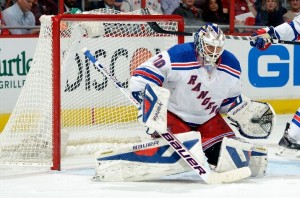As we all know by now, the Rangers have gotten off to a slow start this season. One of the more surprising factors in Blueshirt’s early malaise was the rather pedestrian play of all-world goaltender Henrik Lundqvist. It wasn’t necessarily that he was playing outright badly, just far below the lofty expectations that the fan base has for #30. After posting his first shutout of the year in Washington on Wednesday night, the fan base was able to relax a bit about the form of our number-one keeper.
Buried in a quality post-game piece by Pat Leonard of the Daily News, Hank was quoted as making a small but significant adjustment to his game for the tilt in Washington: he took an extra step out from the goal line for positioning purposes. Hank was quoted on the subject as follows:
“It was more on face-offs I took a step out. My positioning on the ‘D’ shots was a little bit better. A couple times in the early games I got caught deep in my net. That’s the way I play, but there’s been a lot of deflections, (so) you want to come out a little bit more, and today it worked for me.”
As you may or may not know, Hank was pretty much solely responsible for bringing the concept of “goal-line goaltending” to the forefront of the modern game. His natural tendency is to play very deep in his net, but has experimented with the appropriate balance in the past. I may be getting slightly ahead of myself; first let’s get a goalie angle primer out of the way.
Most hockey fans have heard the phrase “cutting down the angle” or “challenging the shooter” from various hockey broadcasters or other fans. The premise behind the notion is simple. The net always remains static, and the closer the goaltender is to the puck carrier, the bigger he will appear and less net will be visible. This theory is based in pretty sound physics. The problem is that there are too many unaccounted for variables in that theory for it to be absolute. First, the goaltender, puck carrier and the puck can all move. The net is the only fixed point. Therefore, not only is there a point of diminishing returns with the distance cut down between goalie and puck carrier, there are also present inefficiencies with regard to future shots or passes.
So, in the scenario which the puck carrier shoots the puck at the challenging goalie, he’s golden. However, if he chooses to pass, carry or deke, the distance that the goaltender finds himself from the cage will determine the efficiency with which the goaltender can acclimate to the various possible outcomes of the puck carrier’s decision making process.
If this sounds overly complicated, don’t worry. Here’s a practical example, and it comes down to skill-sets. When referring to goaltender movement, most of the time “mobility” is a relevant and accurate descriptor. However, when talking about positioning in the crease-depth context, it needs to be split into two categories, “net-mouth mobility” and “range”. Jonathan Quick, for example, has unbelievable range. He gets huge amounts of distance on his lateral pushes and has the ability and positional awareness to stray long distances from the net-mouth without getting himself in (much) trouble.
Hank, on the other hand, has tremendous net-mouth mobility, but very little range. In and around the net, Hank moves very quickly, precisely and efficiently. But he gets himself in trouble when he tries to range too far out of his net, because his strength in movement is short-burst oriented. In the interest of maximizing this strength, Hank positions himself deeper in the net, because it requires less lateral distance to cover the maximum angular spectrum around the net. In contrast to Quick, who has to cover a significantly larger distance to the low post when he challenges three or four feet outside the crease on a puck carrier on the opposite side of the ice.
The downside to the deeper positioning is that you don’t benefit nearly as much from “cutting down the angle” as discussed above, and allows more net to be visible to an oncoming shooter, and gives you less margin for error on incoming deflections. When you look at Hank’s quotes closely, an extra step doesn’t seem to make a big difference in overall positioning, but it can significantly increase the surface area that you are displaying to shooters and allow a greater margin for error when your timing isn’t 100%.
This in-game approach taken by Hank probably won’t be an on-going narrative. Hell, we probably won’t hear anything about it again. However, I always find it interesting when we get little glimpses into a player’s process and adjustments they make when they struggle. Understanding what bad habits or inefficiencies are leading to bad runs of form is incredibly important for players at this level, and to get some first-hand insight into that process doesn’t happen nearly often enough.
More About:Analysis Goaltending

